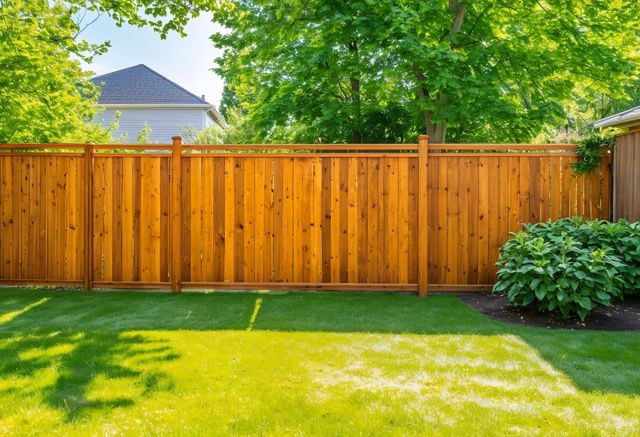To maintain your wood fence, regularly clean it, inspect for damage, and apply sealant or stain to protect against UV rays and moisture. Address common issues like rot, warping, and insect damage promptly to extend its lifespan.
1. Regular Cleaning
Regular cleaning of your wood fence is crucial to maintain its integrity and longevity. Start by inspecting your fence for damage, such as loose boards and rust on metal parts. Use a gentle brush or pressure washer to remove dirt and grime.
Cleaning Tips:
- Use a pressure washer or a gentle brush to clean dirt and moss.
- For mold, mix 20% bleach with 80% mild detergent.
- Avoid harsh chemicals to protect the wood.
After cleaning, consider applying protective coatings such as sealant or paint. These shield the wood from moisture, UV rays, and pests, preventing rot and warping.
Regular inspections are crucial. Check for:
- Loose nails or screws.
- Signs of wear or damage.
- Proper alignment of gates and hinges.
By following these steps, you can keep your wood fence looking great and extend its life to 20 years or more.

2. Sealing and Staining
Sealing and Staining
Treating your wood fence with sealant and stain is vital to shield it from harsh weather conditions like UV rays and moisture. Here’s why it’s important and how to do it:
- Protection from UV Rays: UV rays can cause the wood to fade, dry out, and become brittle. A good sealant acts as a sunscreen for your fence.
- Moisture Barrier: Sealing helps prevent water absorption. This is crucial because moisture can lead to wood rot, mildew, and other forms of decay.
Types of Sealants:
- Water-Based Sealants: Easy to clean, environmentally friendly, and quicker to dry.
- Oil-Based Sealants: Penetrate deeper into the wood, providing long-lasting protection. They are more durable but take longer to dry.
Types of Stains:
- Transparent Stains: Allow the natural wood grain to show through while offering basic protection.
- Semi-Transparent Stains: Offer better protection than transparent stains and add some color without hiding the wood grain.
- Solid Stains: Provide the best protection with a rich color, covering the wood grain completely.
Application Process:
- Preparation: Clean the fence thoroughly, removing any dirt, mildew, or old finish. Use a power washer for best results.
- Choosing the Right Day: Ensure you pick a day when the weather is dry and temperatures are moderate.
- Applying the Sealant or Stain: Use a brush, roller, or sprayer. Start from the top and work your way down to avoid streaking.
- Drying Time: Allow the fence to dry completely, usually 24-48 hours, depending on the product and weather conditions.
Regular upkeep, such as reapplying sealant or stain every 2-3 years, keeps your fence looking fresh and extends its lifespan.
3. Addressing Common Issues
Addressing Common Issues
Identifying and fixing common issues with wood fences can prevent minor problems from becoming major headaches. Here are some practical tips:
Rot Prevention and Repair:
- Regularly inspect your fence for signs of rot. Check posts and panels for soft spots and discoloration.
- Treat any affected areas with a wood preservative.
- Replace badly rotted sections to prevent the problem from spreading.
Dealing with Warping:
- Warping is common in wood fences due to exposure to moisture and temperature changes.
- Ensure proper drainage around your fence to avoid water pooling.
- Reattach or replace warped boards as soon as they are noticed.
Insect Damage:
- Look for small holes, sawdust, or other signs of insect activity.
- Apply an insecticide or seek professional pest control if necessary.
- Use pressure-treated wood which is less prone to insect damage.
By taking these steps, you can greatly extend the lifespan of your wood fence and keep it looking great.

4. Seasonal Maintenance Tips
Section 4: Seasonal Maintenance Tips
Seasonal changes can take a toll on your wood fence. To keep it in top condition, it’s important to perform specific maintenance tasks throughout the year. Here’s how you can protect your fence during different seasons.
Winter Preparation:
- Inspect and Repair: Check for any damage or weak spots in the wood. Repair any broken boards or loose nails to prevent further deterioration.
- Seal and Stain: Apply a water-resistant sealant to protect the wood from moisture. This helps prevent cracks and warping due to freezing and thawing.
- Remove Debris: Clear leaves, snow, and other debris from the base of the fence to avoid moisture buildup and rot.
Spring Maintenance:
- Clean the Fence: Use a brush and mild detergent to remove dirt, mold, and mildew that may have accumulated over the winter.
- Check for Damage: Examine the fence for any new damage caused by winter weather. Repair any issues promptly to avoid larger problems later.
- Re-Seal if Necessary: Depending on the condition of your fence, you may need to reapply sealant or stain to maintain moisture resistance.
Summer Protection:
- Shade and Water Protection: If possible, provide shade to the fence during the hottest part of the day to prevent sun damage. Ensure the fence is not exposed to excessive water from sprinklers.
- Monitor for Pests: Check for signs of insects that could damage the wood. Treat immediately if you notice any infestations.
- Regular Cleaning: Keep the fence clean by removing any pollen, grime, or sap that may build up.
Fall Maintenance:
- Inspect and Clean Again: Look for any damage from the summer and clean the fence to prepare for the upcoming winter.
- Trim Vegetation: Cut back any plants, bushes, or trees near the fence to prevent them from rubbing against or growing on it.
- Apply a Fresh Coat of Sealant: Before the winter hits, ensure your fence has a fresh coat of sealant to withstand the coming moisture and cold.
Regular seasonal maintenance not only extends the life of your wood fence but also keeps it looking its best year-round. For expert fencing solutions and more tips, contact our team at Pickets.

FAQ
How often should I clean my wood fence?
Regular cleaning should be done at least once a year to maintain the fence’s integrity and longevity.
What is the best way to clean my wood fence?
Use a pressure washer or a gentle brush to clean dirt and moss. For mold, mix 20% bleach with 80% mild detergent. Avoid harsh chemicals to protect the wood.
Why should I apply protective coatings to my wood fence?
Applying protective coatings like sealant or paint shields the wood from moisture, UV rays, and pests, preventing rot and warping.
What is the importance of sealing and staining my wood fence?
Sealing and staining protect your fence from harsh weather conditions like UV rays and moisture, preventing fading, drying out, becoming brittle, rot, mildew, and other decay.
What are the types of sealants available?
There are two main types of sealants: water-based sealants, which are easy to clean and environmentally friendly, and oil-based sealants, which penetrate deeper for long-lasting protection.
What are the types of stains for wood fences?
Stains are available in three types: transparent stains, which allow the natural wood grain to show; semi-transparent stains, which add some color without hiding the wood grain; and solid stains, which provide rich color and full coverage.
How often should I reapply sealant or stain to my wood fence?
It is recommended to reapply sealant or stain every 2-3 years to maintain its appearance and protection.
How can I address common issues like rot in my wood fence?
Regularly inspect your fence for signs of rot, treat affected areas with a wood preservative, and replace badly rotted sections to prevent the problem from spreading.
What should I do if my wood fence boards warp?
Ensure proper drainage around your fence to avoid water pooling, and reattach or replace warped boards as soon as they are noticed.
How can I protect my wood fence from insect damage?
Look for signs of insect activity such as small holes or sawdust, and apply an insecticide or seek professional pest control if necessary. Using pressure-treated wood can also help prevent insect damage.
What maintenance should I perform on my wood fence during winter?
Inspect and repair any damage, apply a water-resistant sealant, and clear debris from the base of the fence to prevent moisture buildup and rot.
What maintenance should I perform on my wood fence during spring?
Clean the fence with a mild detergent, check for winter-induced damage, and re-seal if necessary to maintain moisture resistance.
What steps should I take to protect my wood fence during summer?
Provide shade if possible, ensure the fence is not overly exposed to water from sprinklers, monitor for pests, and keep the fence clean from pollen, grime, or sap.
How should I prepare my wood fence for fall?
Inspect and clean the fence, trim surrounding vegetation, and apply a fresh coat of sealant to withstand the winter moisture and cold.

